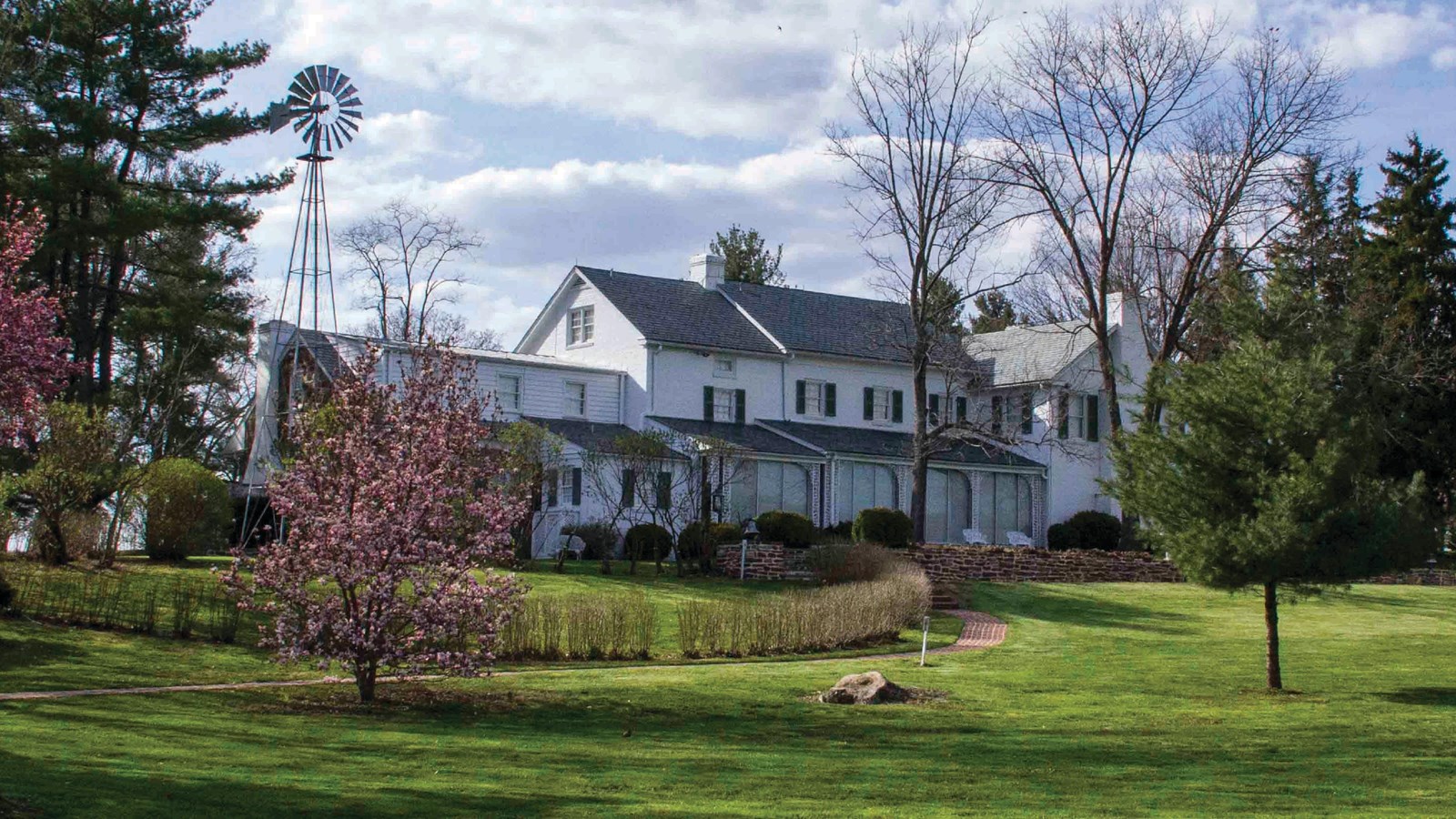Last updated: November 8, 2023
Place
Eisenhower Home

Accessible Rooms, Benches/Seating, Cellular Signal, Historical/Interpretive Information/Exhibits, Information, Information - Ranger/Staff Member Present, Junior Ranger Activity, Junior Ranger Booklet Available
Visiting the House
The Eisenhower home is open for tours seasonally. For information about visiting the inside of the house, check the Operating Hours & Seasons page.
The Eisenhowers in Gettysburg
In 1950—after 34 years of marriage and dozens of moves—the Eisenhowers finally found a place they could call home. Gettysburg, Pennsylvania had loomed large in the life of Dwight David Eisenhower for decades. In May 1915, he first visited the historic town in south-central Pennsylvania with his West Point class. Three years later, as an army captain, 27-year-old Eisenhower was assigned the command of Camp Colt, the U.S. Army tank training camp in the middle of the Gettysburg battlefield. Through the trials and tribulations of 1918, Eisenhower grew as an officer and person. He and Mamie lived in Gettysburg with their first-born child, Doud, who would tragically die in 1921 at the age of 3.
Decades after Camp Colt, Eisenhower was returning to Gettysburg a much different person. He was the victorious 5-star general who oversaw the Allied victory in Europe during World War II. He had then spent several years as the Chief of Staff for the US Army, leaving that post for the presidency of Columbia University in 1948. “Ike”, as he was affectionately known by many, was now looking towards retirement with his beloved Mamie. When they found this 189-acre dairy farm, it was their perfect place. They purchased the property for $44,000, dreaming of a peaceful and tranquil retirement to come.
Soon after buying the farm, Eisenhower was called back to Europe to be the Supreme Commander of NATO forces. The following year, he left that role to run for the presidency, being elected the 34th President of the United States. Over his two terms in office, his Gettysburg farm was a central feature of Eisenhower’s time as president. Ike spent over 365 days here while he was Commander-in-Chief, using the farm for rest and relaxation, as well as a locale for hosting world leaders.
Finally, in 1961, 11 years after buying their farm, the Eisenhowers left the White House and, at long last, had their retirement home of their dreams. The 1960s were happy years for Ike and Mamie, and we invite you to explore the only property that they ever owned in their long and eventful lives together.
History of the Property
The home that Ike and Mamie lived in is not the same house that they originally purchased. This home, and the property it sits on, evolved over time.
The original owner of the property, Quinton Armstrong, built a two-story log cabin on the spot in the 1750s. In the 1830s, a brick veneer was added to the exterior of the original log structure. This was the structure that the Eisenhowers purchased.
Over the course of the 1800s, this property also changed hands several times. At the time of the Civil War, the farm was owned by John Biesecker who rented to Adam Bollinger. The Bollinger family watched Confederate forces march across the farm fields on July 2, 1863, during the Battle of Gettysburg. The farm was outside the main areas of combat but still suffered damage from artillery, trampling, and looting. One of the double log barns on the grounds may have been used by the Confederates as a field hospital.
In 1886, John Biesecker sold the farm to John and Sarah Plank who owned the property until the early 1900s. The Planks built the large bank barn which still stands next to the house today.
When Dwight and Mamie Eisenhower purchased this Gettysburg farm, they intended to live out a quiet retirement here. However, Dwight D. Eisenhower was pulled back into public service and the quiet retirement the Eisenhowers imagined when they purchased the property was put on hold.
Construction and Renovation
Once Dwight and Mamie were in the White House, it was discovered that most of their Gettysburg home was in dire straits due to its advanced age and the deteriorating condition of the wooden interior. The Eisenhowers were advised to raze the home to the ground and start fresh. However, Mrs. Eisenhower wished to save as much of the original home as possible, so she implemented a new plan that saved a portion of the 1800s structure.
That part of the home today contains the kitchen and butler’s pantry downstairs and the maid’s room upstairs. The older brick section has a rougher exterior appearance from the newer brick and is easily visible from outside the house. Because the older and newer brick did not match, the house was painted white. Construction began in the spring of 1953 and was finished in the spring of 1955.
Originally a small summer kitchen had been adjacent to the original house in the 1800s. While all the wooden parts of that structure were removed, the Dutch oven and fireplace were left intact to be incorporated into the new home. The Dutch oven and fireplace, part of the property at the time of the Battle of Gettysburg, were incorporated into the den on the southern side of the Eisenhower home.
The Eisenhowers quickly fell in love with their newly finished home, using it as a respite for rest, relaxation, and recovery during their years in the White House. They hosted numerous world leaders here.
This home was the only home the Eisenhowers owned together, and they would stay here for the rest of their lives.
